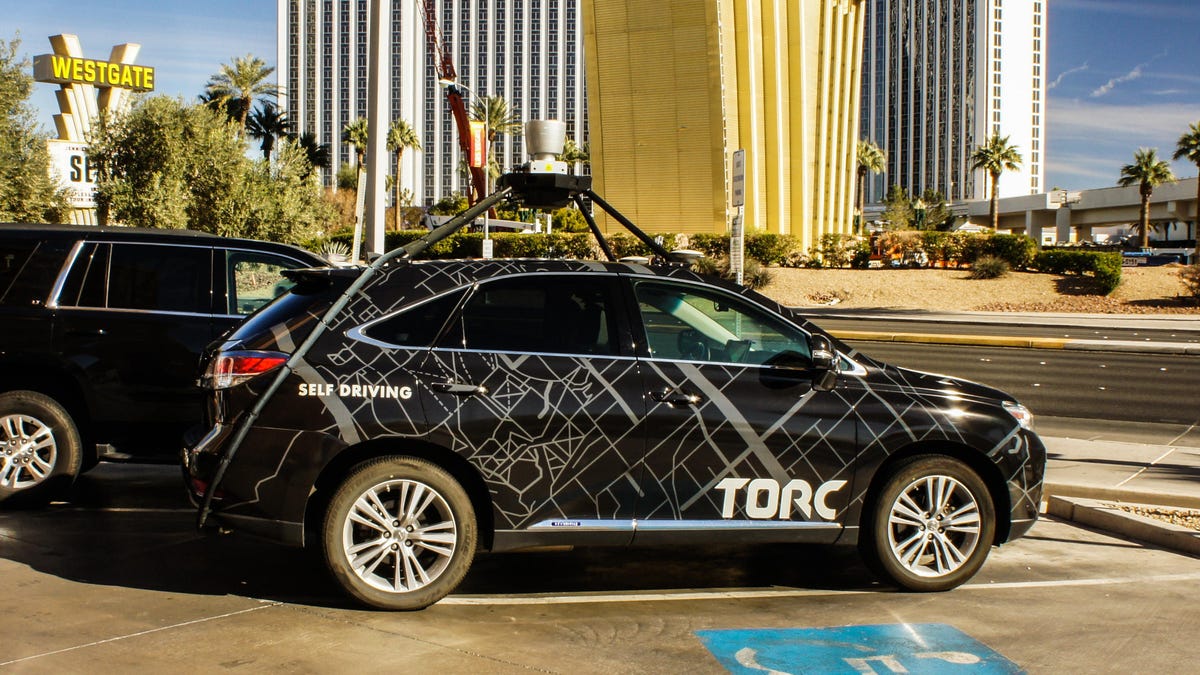Torc car drives itself as well as any human at CES 2018
A drive through Las Vegas in Torc Robotic's self-driving car shows that the technology may be ready for the public.

Torc Robotics brought its self-driving car to CES 2018, demonstrating how it can handle traffic during the convention.
Coming down Paradise Road in Las Vegas, my destination sits on the opposite side of the road. The car I'm in gets into the left turn lane, then pulls a U-turn when the light goes green. All perfectly legal and safe, and what I would have done if I were driving.
Only, this car, a Lexus RX 450h modified by Torc Robotics, is driving itself, and I realize it's the first time I've experienced a self-driving car performing a U-turn.
For the next few minutes, I geek out with Torc CEO Michael Fleming and CTO Ben Hastings, riding in the car with me, about driving paths, vehicle dynamics and steering angles.
That seemingly innocuous moment was just one of the highlights during my ride in Torc's car, as it negotiated Las Vegas streets and freeways. It followed a path of GPS-defined waypoints, using its lidar, radar and cameras to detect its surroundings, and Torc's Asimov self-driving software to figure out how to deal with other traffic, pedestrians and bicycles all while paying attention to traffic lights, lane lines and other infrastructure.
Self-driving car development has picked up incredible steam in recent years, as an array of companies representing traditional automakers, equipment suppliers and big tech all dip their oars in the water. The technology promises not only to make getting around more convenient and accessible, but also to make roads much, much safer.
Although relatively unknown, Torc is an early player among self-driving companies, having partnered with Virginia Tech for its third-place win in the DARPA Urban Challenge in 2007, a government-sponsored contest calling for researchers to tackle an urban environment with self-driving car technology. Fleming points out that Torc ranks with Google among the earliest private companies focused on self-driving cars.
Torc fitted this Lexus RX 450h with a lidar array, cameras and radar. However, the company is focused on developing the software for self-driving, so it partners with sensor and chip suppliers.
Over the last few years, I've experienced more than a few rides in self-driving cars, on both closed tracks and public roads. This ride in Torc's vehicle showed the maturity of its software, as the car handled an array of challenges with very humanlike, yet safe, behavior.
The day's bright sunlight created glare on the streets, making it difficult for me to see the lane lines. However, the car kept its position perfectly, and Torc notes that its technology works in the rain, as well.
In a right turn lane, a couple of other cars cut in front of us, nosing into the lane. Torc's car tapped the brakes a few times, a little less smoothly than I might have done, but it let the other cars in without drama, quickly resuming its following distance.
Stopped at a light, a confused driver ahead put his right signal on, switched it to the left signal, then ultimately pulled into the left turn lane. No problem, as the Torc car sensed the space opening up in front of us and pulled in behind the next car up in the lane.
Of course, cars face many more challenging situations on the road that we didn't encounter. Fleming showed me a video taken in earlier testing where another car was actually going the wrong way down the street. The Torc car took appropriate measures, braking and letting the other car get out of the way before proceeding.
In talking about Torc's self-driving software, Fleming espouses the guiding principle, "What is the safest thing for this vehicle to do?"
Can Torc's self-driving software handle every situation that might come up on the road? "There an infinite number of corner cases," says Fleming. However, Torc has accumulated petabytes of driving data over 10 years of testing. Each time something out of the ordinary happens, such as a wrong-way driver, Torc logs how its car handled the situation, potentially making refinements to what the car should do. The next time a similar situation comes up, any car using the Torc software will act from this experience.
Torc accumulates this data not only through testing on public roads, but also on test tracks and in a virtual environment. Many of the corner cases the software needs to deal with will rarely be found in public, but engineers can dream up scenarios that might occur and put them to the test.
All of this testing seems to be paying off. Torc joins a number of other companies, including Aptiv and Navya, putting their self-driving cars onto the Las Vegas streets during CES 2018, letting convention attendees get their first rides in what will be the future of transportation.

